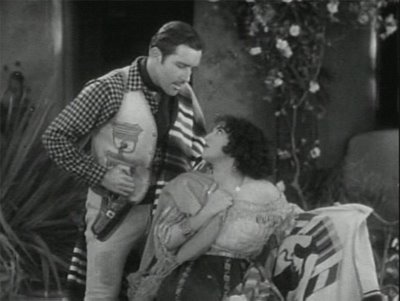Rio Rita
 Nothing better illustrates the fact that Hollywood's Latin movies can't be restricted to a single genre than Rio Rita.
Nothing better illustrates the fact that Hollywood's Latin movies can't be restricted to a single genre than Rio Rita.This movie is a rather bizarre hybrid on many levels. It's the film version of an immensely successful stage show, that had racked up almost 500 performances on Broadway. Though mostly black and white, the last half hour is a rare example of early Technicolor. And, generically, it combines musical (a very early example of the genre), western, and comedy, with two parallel (scarcely overlapping) plots both set just south of the Rio Grande.
The main plot concerns the search for outlaw "Kinkajou" who is terrorizing both sides of the US/Mexican border. (The film claims that "kinkajou is Mexican for wild cat," but in fact these little "honey bears" are closer to raccoons, which is not to say they can't be dangerous.) On his trail is the Texas Ranger Captain Jim Stewart, who has crossed the border incognito to find his man. Suspicion soon falls on a shady-looking character, one Roberto Ferguson, but things become complicated as Jim falls for Roberto's sister, the eponymous Rita. Meanwhile, a Russian aristocrat named General Ravinoff, his presence in these parts unexplained, is also after Rita's affections. Ravinoff captures Ferguson and tries to kill Stewart, and so to save both brother and lover Rita agrees to marry the dastardly general.
At the same time, we also see the story of small-time bootlegger and man-about-town Chick Bean, his lawyer Ned Lovett, and his two wives, Katie Bean and Dolly Bean. Lovett had fixed for Bean to get a Mexican divorce from his first wife, Katie, only to discover belatedly that Mexican divorces aren't legal in the USA. So Bean is an inadvertent bigamist, a fact he tries to keep from new wife Dolly. Meanwhile, when Katie turns up from New York and announces that she has just inherited $3 million, Lovett does his very best to make her his. Somewhat predictable hilarity ensues, in which Bert Wheeler and Robert Woolsey (playing Bean and Lovett) revive their vaudeville success, and with Dorothy Lee (Dolly) lay the basis for what would be a rather successful cinematic career as a comedy trio.
Both plots are interrupted not only by set-piece musical numbers, but also by elaborate choreographed dance sequences, some of which are reminiscent of Busby Berkeley numbers, complete with an innovative overhead shot of dancing girls geometrically arranged.
The film's climax is a sumptuous reception on a pirate barge (!) moored in the Rio Grande, just on the Mexican side of the border that runs through the river. It is here that the various Beans play out their comedic excess with Lovett. And it is here that Ravinoff plans to wed Rita. His plans are thwarted, however, by Jim's reappearance: the Ranger cuts the tether holding the barge to the Mexican bank, allowing it to drift over to US territory where he arrests the Russian, now revealed to be the elusive bandit. Rita's brother Roberto, therefore, is found to be not the Kinkajou as originally feared, but also an agent of law enforcement, working undercover with the Mexican secret service. And so a wedding takes place, but it is the American who weds the fiery young Rita, not the Russian.
So what's interesting is the way in which the film portrays the fluidity and permeability of the US/Mexican border as ultimately something to be celebrated. If it weren't for the current that sweeps the barge northwards, the Rangers wouldn't have caught the bandit. And the film's most significant romance is that between the straight-laced US lawman and the Latina temptress, who is rather more unbuttoned (especially in her opening scene). Jim disguises himself by throwing a serape over his shoulder. But his investment in latinidad proves to be outcome of a long-standing fascination. "But you've never seen me before," says Rita to Jim. "Oh yes, I have," he replies. "From down there across the Rio Grande I've watched you."

Finally, then, though Rio Rita flirts with the notion of a threat from south of the border, instead its emphasis is on the border as mirror. For far from being the criminal other, Roberto proves to be the Texas Ranger's counterpart and opposite number, similarly disguised, similarly motivated, and similarly attached to "Rio Rita." The exchange of women between the two men cements their relationship, as also the partnership between South and North, at the same time that they successfully expel the foreign interloper, the displaced European who brings Bolshevik resonances to his aristocratic demeanour. It is by handing Ravinoff over to the Mexicans that Jim wins the right to wed Roberto's sister.
This is the Monroe doctrine as happy synthesis: (literally) the marriage of two equal partners, each determined to rid themselves of European influence in favour of a fluid pan-Americanism, lubricated by desire, and by song.
